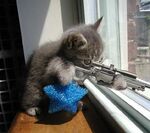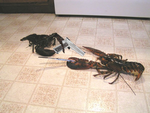Guard animals
Guard animals are widely used as a security measure for homes, businesses, military bases, and the secret hideouts of evil geniuses. They are often utilized when one is too cheap to hire trained guards or set up an automated security system. Guard animals are popular for their relatively low cost, easy maintenance, additional usefulness as pets, and the entertainment they provide their masters once an intruder has been caught.
History[edit]
The earliest known evidence of humans using guard animals dates back to the time of cavemen, when mankind first tamed the wolf to serve as a cute and cuddly pet. These wolves still maintained some degree of being wild during the process of domestication, and they would inevitably attack humans who stroked their fur the wrong way or forgot to take them out on walks. Most of these wolves were artificially selected against to produce the relatively docile modern dog, but some of the more sadistic cavemen had better ideas. They kept these wolves to guard their caves against bears, burglars, and burglars riding bears. Over time, early wolf breeders managed to cross the viciousness of these wolves with the smaller size of most dogs to increase their danger density, which led to the invention of the pitbull.
For several millennia, technological progress in the field of guard animals stagnated. However, as the threats guard animals were meant to protect against became more sophisticated, the animals used needed to become more specialized and formidable. This lead to the wide variety of guard animals employed today.
Types[edit]
There are many kinds of guard animals in use today, each with its own pros and cons for certain applications.
Wolves[edit]
The first true guard animal domesticated by humans. Wolves understand what it means to be part of a pack, giving them an undying loyalty to their masters. However, they can turn on their owners in a flash if they become mildly annoyed by something. When they howl at the moon, it means they are not being provided enough prey and could devour their owner if an intruder does not come by soon. Thus, they are great for keeping those kids off of your lawn, but they have the danger of turning rogue if the kid supply starts to dry up.
Dogs[edit]
Dogs are the most well-known type of guard animal in use. They can be a good substitute for wolves if the supply of trespassers is too low to guarantee your own personal survival. Part of this is due to dogs generally being a sissier version of wolves with a decreased thirst for blood, and part of it is because dietary supplements in the form of stray cats, squirrels, and smaller dogs help placate them.
It should be noted that the ability of dogs to be good guard animals varies considerably. This can be by breed, and also by individual animal. Some dogs do not take nonsense from anybody, and others are so stupid they will just happily lick their own crotch while burglars walk right on past to your brand-new HDTV. Those looking for serious protection will likely choose pitbulls, which have retained all of the viciousness of their wolf ancestors while also coming in a more portable form factor. Experts agree that the only known living things which can survive a pitbull attack are other pitbulls, or possibly honey badgers.
Dogs can double as a traditional pet, and love to have their bloodstained fur petted right after devouring their latest victim. In particular, pitbulls make excellent additions to families with infants or young children.
Cats[edit]
Cats can do a decent job of keeping intruders out of a home, if they feel like it. Like a stupid dog, a cat which simply could not care less about its owner (i.e., virtually all of them) will happily lick its own crotch as the burglars who stole your HDTV come back in and walk right past it to take your DVD player next. However, even an apathetic cat can trigger the allergies of susceptible intruders, and a sufficiently agitated cat can always use its claws against friend and foe alike.
Lobsters[edit]
Growing in popularity as guard animals, lobsters are notable for their easy care, resilient armor plating, and claws which can maim by themselves or wield an assortment of conventional weapons against attackers. If properly cared for, and fed the right mixture of cat food and uranium, they can grow to multiple feet in length; at this stage, a single pinch from one of their claws can slice a grown man in half.
Red Lobster restaurants are the most well-known users of guard lobsters, kept visible in glass aquariums in the front lobby as a deterrent to would-be robbers. In the event of criminals barging in or somebody forgetting to pay their exorbitant bill, employees are instructed to remove the rubber bands from their claws, which allows the lobsters to unleash their full power and mercilessly kill the offending party. The lobsters will then clean up the corpse by eating it, then they go back to wait patiently in their tank until a customer in turn orders one for dinner.
Crocodiles/Piranhas[edit]
Crocodiles and piranhas are most popularly kept at the bottom of pits for undesired visitors to fall into. Wealthy criminal masterminds may opt to keep them in a display case for easy viewing when someone is dropped in. When secret agents are in short supply and cannot provide an adequate food supply, Jehova's Witnesses and door-to-door salesmen can fill the gap when the pit entrance is cleverly hidden under the welcome mat at the front door.
Others[edit]
Anything which is on the list of Top Ten Most Murderous Animals can be employed as a guard animal, but only by a licensed professional. Anybody else who tries to keep one on their own is subject to ending up at the bottom of the food chain.
Animals classified as living weapons are not suitable for use as guard animals, although some try it anyway. A few scientists have attempted to repurpose these animals as guard animals for the home in a bid to earn a Nobel Prize, but have more commonly achieved the slightly less prestigious Darwin Award.
Criticism[edit]
Guard animals are a popular form of security, but they also face a variety of criticisms.
One of the more persistent sources of complaints regarding guard animals comes from animal rights groups, who feel that it is inhumane to use animals to fend off intruders. Those who defend the use of guard animals point out the many health benefits the occupation provides, including saving the animals involved from starvation or boredom. Animals which are used in security applications have significantly longer and more exciting lives than those which fall under the care of PETA.
Another criticism is that it is more difficult to maintain guard animals by ensuring a continual food supply and cleaning up after them than it would be to use conventional human guards. It is actually easier to feed guard animals in most instances, as the food they eat is typically less expensive than the gourmet dinners human guards prefer and try to demand through higher wages. Some older human guards looking for jobs to supplement their Social Security checks offer to eat dog food as a promise not to request raises, but savvy clients know that old people just like how dog food tastes to their aging taste buds and would eat it anyway. Also, the waste problem is resolved by actively training guard animals to employ "reduce, reuse, recycle" techniques, and unlike human guards they typically have no problem with eating the bodies of other animals which may be killed in the line of duty.






